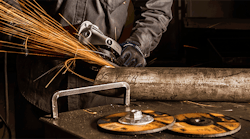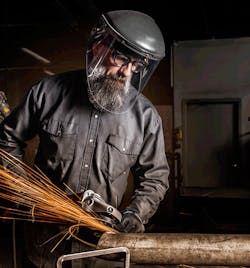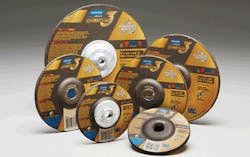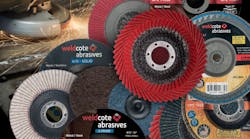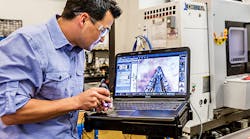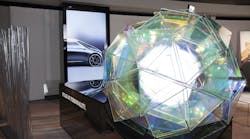Reinventing the (Grinding) Wheel
You always get what you pay for. In the calculus of cost savings, that is the cardinal rule. It's also the first thing we forget. For Norton, a brand of Saint-Gobain, this math is a critical component of its product innovation process.
According to the company's figures, the total cost of grinding, finishing, and abrasives accounts for about 17% of the annual operating costs for large metal fabrication plants. Of that 17%, only 2% goes to abrasives like the grinding wheels the company is known for. All the rest goes to less tangible costs—labor, equipment wear, and so on.
The smart move to cut costs in this scenario, of course, is to bring down the 15%—in this case, to improve operator efficiency and minimize wear on tools. But too often, that low-hanging fruit of abrasive costs proves too tempting to resist.
And so, the cardinal rule goes out the window: fabricators buy grinding wheels that last longer or cut metal faster in order to drop that 2% down a decimal point or two.
But, as Debbie Gaspich—director of product management for thin wheels and construction products of Saint-Gobain Abrasives—sees it, that calculation is missing one vital integer, without which the whole equation is out of balance.
"Grinding wheels," Gaspich explains, "should be measured on three axes: the life of the wheel, the cut rate of the wheel, and how the wheel really performs for the user."
Considering that third element—how the product feels and how easy it is to control—is missing in most products on the market today. That absence can have significant ramifications for both worker and plant efficiency.
The Cost of Cost Cutting
According to Gaspich, many fabricators turn to ceramic abrasives because, in general, they promise a long life in the field, which seems like a very good thing. However, most manufacturers want to make the wheels very long-lasting and do so by adding more bond to the mixture.
"The problem with this is that users really have to bear down on the workpiece in order to get the wheel to cut," she explains. "The wheel might last a long time, but the amount of energy the user needs to apply costs them in ergonomics and fatigue."
"These wheels are so rough acting that the wheel jumps from the cut," Gaspich adds. "The wheel just isn't controllable from the user's perspective."
On the other end, grinding wheels that focus on quick removal rates are fast cutting and easy to control but wear away quickly, so you still have more work to do—costing you more in the number of wheels and wheel changes.
The result of this, of course, is exactly what you'd expect: saving money by buying inferior wheels that only do one part of the job ends up with exhausted workers, lower efficiency, more injuries, and damaged equipment.
In other words: reducing costs on one side just adds more on the other.
Reinventing the Wheel
To settle this equation, Saint-Gobain Abrasives has reimagined the grinding wheel, reformulating its entire manufacturing recipe to create a new product that combines all three parts of the problem: life, speed, and feel.
"We looked at the whole manufacturing process," Gaspich explains. "We started with the abrasive grain, then what components we put into the bond mixture, how that bond held onto the grain during the grinding process, and then all of the processes it goes through before becoming a finished product—how it is baked, how it is cured, how it is cooled."
Basically, she says, "we started at ground zero and we re-engineered the product from a brand new process."
The result of all this work is a product the team has dubbed the Norton Quantum3 (NQ3)—a depressed center grinding wheel custom-built to deliver all three parts of the optimal grinding experience.
The company maintains that the wheel's unique bond mixture and proprietary grain structure bring it industry-leading removal rates along with long life and even wear. But more to the point, it boasts significant improvements in feel, control, and operator comfort compared to other ceramic abrasives.
"Our wheels, because of the shape of the grain, are much smoother acting, which means it's easier for the guy doing the work to control the grind in both directions," Gaspich notes. "It gives him much smoother grinding action as he is doing his work."
Proof in the Pudding
Taking a look at the performance stats for the NQ3, it looks like the product really does live up to this hype.
In a recent whitepaper, Saint-Gobain compares aluminum oxide wheels against Norton ceramics. Just 20 ceramic wheels, the study proved, did the same job as 100 aluminum oxides.
Furthermore, when adding the cost of labor to change wheels and the overall reduction in time spent actually grinding, the company reported an 80% drop in the cost of labor.
Add to that a reported 20 to 100% increase in removal rates over the life of the wheel for the NQ3, and Gaspich's excitement about the innovation finds firm footing.
"It all comes down to this," she says, "Norton Quantum3 is the best in cut rate, it's the best in life, and it's the best in feel for the user."
"All of these things add up to a better product," she notes. "All of these things add up to a reduction in costs."










